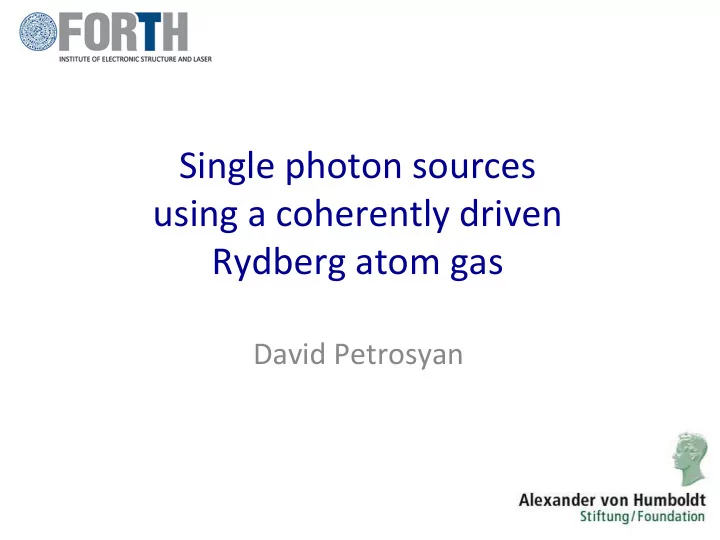

Single photon sources using a coherently driven Rydberg atom gas David Petrosyan
How to produce single photons? Using single emitter strongly coupled to a resonant cavity ( Γ < g ) e Excitation Cavity photon pulse s g
How to produce single photons? Using the DLCZ scheme (probabilistically) e Idler Write photon pulse s g e Read Signal pulse photon s g
How to produce single photons? Using massive Rydberg superatom (full blockade) r Control pulse Excitation e pulse photon g
Nearly-deterministic, free-space source of single photons Combine the best properties of the CQED, Rydberg SA & DLCZ schemes • Prepare a single atom in an excited state (using a laser) • Transfer the single excitation to a large atomic ensemble to create a spin-wave with proper spatial phase (using long-range dipole-dipole interactions between the atomic Rydberg states) • Convert the spin wave to photon wave-packet emitted in the phase-matched direction (using a control laser) D. Petrosyan, K. Mølmer, arXiv:1806.07094 [quant-ph]
Step 1: Single atomic excitation s u d i e g z | Ψ 1 ⟩ = | u ⟩ ⊗ | G ⟩ | G ⟩ ≡ | g 1 , g 2 , . . . , g N ⟩
Step 2: Single collective excitation s δ u D D d ∆ i e Ω g z S ~D ( ) r ( ) r r − s � N j =1 ˜ D j e i k 0 · r j | g 1 , g 2 , . . . , s j , . . . , g N ⟩ | S ⟩ ≡ 1 | Ψ 2 ⟩ = | d ⟩ ⊗ | S ⟩ ¯ D D j | 2 � 1 / 2 � � N D j ≡ − D ( r − r s ) Ω ˜ ¯ j | ˜ D ≡ ∆ | r − r s | 3 (1 − 3 cos 2 ϑ ) C 3 ℘ ≈ n 2 ea 0 C 3 = ℘ si ℘ du D ( r − r s ) = 4 π� 0 � ,
Step 3: Single photon emission s u θ = π /2 x d Ω k k − c c i k ∆θ x 0 θ =0 x e x k ˆ E θ x z θ = π /2 y θ g y k y ∆θ y θ =0 y z ˆ E P ∆Ω ≃ η N ∆Ω / 4 π � 0 . 7 S ~D ( ) r ( ) r r − s ∆Ω = 2 π (1 − cos ∆ θ ) | Ψ 3 ⟩ = | d ⟩ ⊗ | S ⟩ ⊗ | 1 phot ⟩ | 1 phot ⟩ ≡ � k a k | 1 k ⟩ ˜ gk Ω ∗ Dj Γ e ( ck − ω eg ) / 2+ i | Ω c | 2 for t � Γ e/ 2 D e i ( k 0 − k c − k ) · r j c a k = − ˜ g k ( t ) � g k ≃ ˜ ¯ | Ω c | 2 j
Phased-array optical antenna with atoms in a lattice Subwavelength interatomic distances, two or more layers Rydberg implementation Shaping the spatial distribution of the emitted radiation by tailoring the phase and amplitudes of the antenna atoms Fixed atomic positions, Control of spatial phase and amplitude of Ω d A. Grankin, P. O. Guimond, D. V. Vasilyev, B. Vermersch, P. Zoller, arXiv:1802.05592 [quant-ph]
Single photon filter using dipolar exchange induced transparency with Rydberg atoms D. Petrosyan, NJP 19 , 033001 (2017)
Electromagnetically Induced Transparency 1.0 0.8 Absorption 0.6 0.4 e ∆ 0.2 ˆ Γ η E 0.0 e 0.6 g 0.4 Dispersion 0.2 0.0 − 0.2 − 0.4 ˆ E − 0.6 − 4 − 2 0 2 4 Detuning ∆ / γ e Stationary propagation 2LA medium susceptibility
Electromagnetically Induced Transparency r 1.0 δ 0.8 Absorption Γ 0.6 r Ω d 0.4 e ∆ 0.2 ˆ Γ η E 0.0 e 0.6 g 0.4 Dispersion 0.2 0.0 Ω d − 0.2 − 0.4 ˆ E − 0.6 − 4 − 2 0 2 4 Detuning ∆ / γ e Stationary propagation EIT (3LA) susceptibility
Pulse propagation in EIT medium r Γ r Ω d e ∆ Γ e ˆ η E g Ω d v g ˆ ( ) z,t E V= N ρ
Dipolar Exchange Induced Transparency r u D D as as d ∆ c i D Ω c e ∆ Γ e ∆ r J = n /2 ˆ η E s g x s D z ( ) v z ( ) ˆ g ( ) z,t E ρ L= N
DEIT medium response 1 Absorption 0.8 0.6 0.4 0.2 0 2 4 6 8 Position z ( m) 10 12 14 10 8 16 6 µ 4 18 2 0 20 ∆ / γ e -2 Probe detuning -4 22 -6 -8 24 -10
Summary Strong, long-range dipole-dipole exchange interactions between Rydberg atoms can be used to couple a singe atom to a large atomic ensemble Excitation of a single emitter can be converted to a collective medium excitation Single photons can then be emitted with large probability into the phase-matched spatial direction [arXiv:1806.07094] State transfer between single atomic qubits coupled to optical phase-array antennas can be achieved [arXiv:1802.05592] In DEIT n s “spin” atoms can play the role of the quantized control field Ω d of the EIT The system can serve as photon number filter or transistor for n p ≤ n s photons Poster: Simulating spin-lattice models with cold Rydberg atoms
Recommend
More recommend